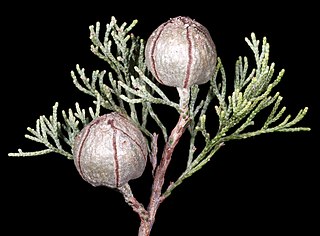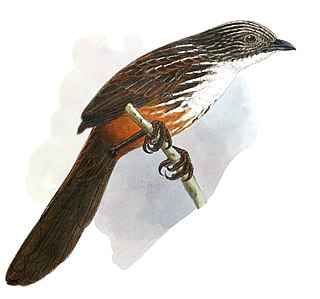
Millets are a group of highly variable small-seeded grasses, widely grown around the world as cereal crops or grains for fodder and human food. Most species generally referred to as millets belong to the tribe Paniceae, but some millets also belong to various other taxa.

Sorghum is a genus of about 25 species of flowering plants in the grass family (Poaceae). Some of these species are grown as cereals for human consumption and some in pastures for animals. One species, Sorghum bicolor, was originally domesticated in Africa and has since spread throughout the globe. Seventeen of the 25 species are native to Australia, with the range of some extending to Africa, Asia, Mesoamerica, and certain islands in the Indian and Pacific Oceans. One species is grown for grain, while many others are used as fodder plants, either cultivated in warm climates worldwide or naturalized in pasture lands. Sorghum is in the subfamily Panicoideae and the tribe Andropogoneae.

The International Union for Conservation of Nature (IUCN) Red List of Threatened Species, founded in 1964, is the world's most comprehensive inventory of the global conservation status of biological species. It uses a set of precise criteria to evaluate the extinction risk of thousands of species and subspecies. These criteria are relevant to all species and all regions of the world. With its strong scientific base, the IUCN Red List is recognized as the most authoritative guide to the status of biological diversity. A series of Regional Red Lists are produced by countries or organizations, which assess the risk of extinction to species within a political management unit.

Podocarpus totara is a species of podocarp tree endemic to New Zealand. It grows throughout the North Island and northeastern South Island in lowland, montane and lower subalpine forest at elevations of up to 600 m.

Cypress is a common name for various coniferous trees or shrubs of northern temperate regions that belong to the family Cupressaceae. The word cypress is derived from Old French cipres, which was imported from Latin cypressus, the latinisation of the Greek κυπάρισσος (kyparissos).
Juniperus indica, the black juniper, is a juniper native to high-altitude climates in the Himalaya, occurring in Pakistan, India, Nepal, Bhutan and China.

The conservation status of a group of organisms indicates whether the group still exists and how likely the group is to become extinct in the near future. Many factors are taken into account when assessing conservation status: not simply the number of individuals remaining, but the overall increase or decrease in the population over time, breeding success rates, and known threats. Various systems of conservation status exist and are in use at international, multi-country, national and local levels as well as for consumer use.

Andropogon is a widespread genus of plants in the grass family, native to much of Asia, Africa, and the Americas, as well as southern Europe and various oceanic islands.

Johnson grass or Johnsongrass, Sorghum halepense, is a plant in the grass family, Poaceae, native to Asia and northern Africa. The plant has been introduced to all continents except Antarctica, and most larger islands and archipelagos. It reproduces by rhizomes and seeds.

Sorghum bicolor, commonly called sorghum and also known as great millet, broomcorn, guinea corn, durra, imphee, jowar, or milo, is a grass species cultivated for its grain, which is used for food for humans, animal feed, and ethanol production. Sorghum originated in Africa, and is now cultivated widely in tropical and subtropical regions. Sorghum is the world's fifth-most important cereal crop after rice, wheat, maize, and barley, with 59.34 million metric tons of annual global production in 2018. S. bicolor is typically an annual, but some cultivars are perennial. It grows in clumps that may reach over 4 m high. The grain is small, ranging from 2 to 4 mm in diameter. Sweet sorghums are sorghum cultivars that are primarily grown for forage, syrup production, and ethanol; they are taller than those grown for grain.

Commercial sorghum is the cultivation and commercial exploitation of species of grasses within the genus Sorghum. These plants are used for grain, fibre and fodder. The plants are cultivated in warmer climates worldwide. Commercial Sorghum species are native to tropical and subtropical regions of Africa and Asia.

Callitris canescens is a species of conifer in the family Cupressaceae. It is found only in Australia.

The white-throated grasswren is a species of bird in the family Maluridae. It is endemic to Australia.

Helicia is a genus of 110 species of trees and shrubs, constituting part of the plant family Proteaceae. They grow naturally in rainforests throughout tropical South and Southeast Asia, including India, Sri Lanka, Indochina, Peninsular Malaysia to New Guinea and as far south as New South Wales.

Protea curvata is a species of plant in the family Proteaceae. It is endemic to South Africa, and a protected tree there.

Eidothea hardeniana, commonly named nightcap oak, is a species of tree, up to 40 m (130 ft) tall, of the plant family Proteaceae, which botanist Robert Kooyman recognised as a new species only recently in 2002. The species has an official listing as critically endangered on the Australian Commonwealth EPBC Act and as Endangered on the NSW Threatened Species Act. The name hardeniana honours the botanist Gwen Harden. Phylogenetics studies now suggest it represents a basal branch of the Proteoid clade of the Proteaceae.
Sesamia cretica, the corn stem borer, greater sugarcane borer, sorghum stem borer, stem corn borer, durra stem borer, large corn borer, pink sugarcane borer, sugarcane pink borer, sorghum borer, pink corn borer, maize borer or purple stem borer, is a moth of the family Noctuidae. It was described by Julius Lederer in 1857. It is found in most of the countries and islands of the Mediterranean basin. The range extends through the Middle East and Arabia to Pakistan, northern India and northern Africa. In the south, the range extends to northern Kenya and northern Cameroon.
Helicia blakei, also named Blake's silky oak, is a species of rainforest tree, of northeastern Queensland, Australia, from the flowering plant family Proteaceae.
Helicia nortoniana, also named Norton's silky oak, is a species of rainforest trees, of northeastern Queensland, Australia, from the flowering plant family Proteaceae.

Sorghum arundinaceum, the common wild sorghum, is a species of flowering plant in the family Poaceae. It is native to Sub‑Saharan Africa, Madagascar, many of the Indian Ocean islands, and the Indian Subcontinent, and has been introduced to northern South America, the US states of California and Florida, Puerto Rico, Taiwan, New Guinea, and a number of smaller islands worldwide. It is the wild progenitor of cultivated sorghum, Sorghum bicolor, with some authorities considering it to be a mere variety or subspecies; Sorghum bicolor var. arundinaceum, or Sorghum bicolor subsp. verticilliflorum.















